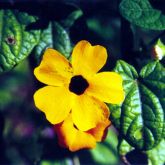Black-eyed Susan

Black-eyed Susan flower
© Queensland Government

Black-eyed Susan leaf
© Queensland Government

Black-eyed Susan plant
© Queensland Government
Black-eyed Susan is a species of Thunbergia, which are vigorous, perennial, twining vines native to northern India and tropical Africa.
Black-eyed Susan takes its name from the black centres of its striking yellow-orange flowers. A popular garden species, black-eyed Susan can smother native vegetation if it spreads into native bushland. It has become common in coastal regions of Queensland.
Black-eyed Susan is not a prohibited or restricted invasive plant under the Biosecurity Act 2014.
Scientific name
Similar species
- Thunbergia spp.
Description
- Slender-stemmed vine up to about 4m long.
- Leaves are pale green, paired, roughly triangular to heart-shaped, 3–4cm long, with soft fine hairs and broadly toothed margins.
- Flowers are bright yellow-orange, with striking black centre 3–4cm wide, 5 petals, on long stalk.
- Seed capsules are round to a beak, 6–8mm, burst open to shoot out seeds.
- Seeds are brown, shiny, round, 4mm.
- Roots form at nodes of stem when they come into contact with soil, anchoring plant and forming new plants.
Habitat
- Grows along waterways, in urban bushland and on forest margins.
Distribution
- Found along coast from North Queensland to New South Wales border.
Life cycle
- Flowers throughout year, mostly in spring and summer.
Impacts
Environmental
- Can spread from gardens into bushland, threatening native vegetation.
How it is spread
- Spread by seed and vegetatively by fragments of stems and roots, generally in dumped garden waste.
Prevention
Control
Physical control
- Hand-pull roots.
- Mulch heavily to prevent regrowth.
- Take care to ensure your own and others safety when trimming or lopping black-eyed Susan near power lines. Read more on Worksafe website.
Herbicide control
- No herbicide is currently registered in Queensland; however, off-label use permit (Permit No. PER11463) allows use of various herbicides for control of environmental weeds in non-agricultural areas, bushland, forests, wetlands, and coastal and adjacent areas.
Legal requirements
- Black-eyed Susan is not a prohibited or restricted invasive plant under the Biosecurity Act 2014. However, by law, everyone has a general biosecurity obligation (GBO) to take reasonable and practical steps to minimise the risks associated with invasive plants under their control.
- Local governments must have a biosecurity plan that covers invasive plants in their area. This plan may include actions to be taken on Black-eyed Susan. Some of these actions may be required under local laws. Contact your local government for more information.